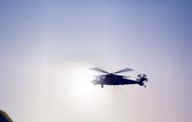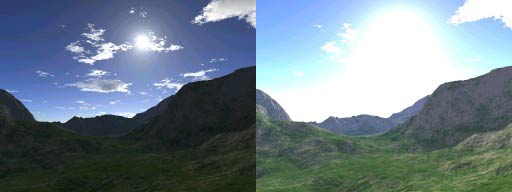Lighting: Dynamic Range
- the real world has much, much higher dynamic range than computers currently
allow
- it would be great to model the actual light values of each objects, in realistic
units, then dynamically map a clipped range of values onto the actually 0-255
range of the output display.
- this would allow for day/night rendering of emissive sources (sun, moon,
stars, streetlights etc.) in as realistic a fashion as possible
- this is still a new area of research
-
 the
abbreviation is usually "HDR" or "HDRI" for High Dynamic Range Images
the
abbreviation is usually "HDR" or "HDRI" for High Dynamic Range Images
- Johan Hammes's
Dynamic Eye Modeling
- visual examples of his approach to the "glare" effect of the human eye's
reaction to light
- Gregory Ward Larson has done
tons of work in this field
- Paul Debevec has done lots
of work in this area
- many, many academic papers on HDR imaging
- HDR Shop is a program
for manipulating HDR images
- Jack Tumblin says "Computer
graphics rendering should mimic human vision, not film cameras; it should include
more of the light-dependent changes in the way we see."
-
HDRI & Luminance space is a overview and explanation in layman's terms
- consider that TV/Video material on CRTs has the same brightness range as
a computer screen, yet people find that level of realism convincing: with the
right combination of level balancing and tricks like lens flare, it is therefore
logically possible to reproduce the effect of that extra brightness without
actually emitting more photons.
-
 OpenGL
1.2 added some interesting sounding imaging extensions which may provide some
hardware assistance for histogram functions
OpenGL
1.2 added some interesting sounding imaging extensions which may provide some
hardware assistance for histogram functions
- Exposure
by Hugo Elias
- discusses the dynamic range problem by analogy to photography
- input from Deanan: "I've done some
10/12 bit stuff on the onyx which was really nice. It might be possible
to do some realtime histogram stuff but I've not timed how fast the OpenGL histogram
extensions are."
 the
abbreviation is usually "HDR" or "HDRI" for High Dynamic Range Images
the
abbreviation is usually "HDR" or "HDRI" for High Dynamic Range Images OpenGL
1.2 added some interesting sounding imaging extensions which may provide some
hardware assistance for histogram functions
OpenGL
1.2 added some interesting sounding imaging extensions which may provide some
hardware assistance for histogram functions